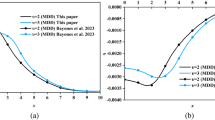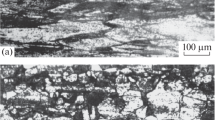Abstract
When an elastic body is heated rapidly, significant inertial stresses are developed if the imposed heating rates cause a substantial temperature change in times which are short relative to the mechanical response time of the body. This work describes a method for inducing and measuring the thermally induced elastic stress waves in an unrestrained thin rod. Rapid heating was accomplished electrically by discharging a low-inductance capacitor bank (0.1 μH, 2800 J) through the rod. Utilizing the frozen-stress technique, an initial fringe pattern was introduced into thin strips of a birefringent material securely bonded to each side of the rod. The longitudinal strain oscillations were measured by direct observation of the movement of the fringe patterns with a high-speed framing camera. Interpretation of these measurements required a dynamic calibration and application of a dynamic correction factor for the reinforcing effect of the coating. Oscillations with periods from 35 to 250 μsec and stress amplitudes up to 900 psi were measured and compared with the uncoupled thermoelastic theory. Good agreement was obtained, and it was concluded that this technique is suitable for transient measurements in the presence of large magnetic fields which normally restrict the use of electronic methods.
Similar content being viewed by others
Abbreviations
- A :
-
cross-sectional area, in.2
- a :
-
sonic velocity, in./sec
- c :
-
specific heat, Btu/lb/° F
- C :
-
capacitance, μF
- E :
-
elastic modulus, lb/in.2
- f ε :
-
strain-optic coefficient, in./in./fringe/in.
- f σ :
-
stress-optic coefficient, lb/in.2/fringe/in.
- h :
-
thickness of birefringent coating, in.
- i :
-
current, amp
- l :
-
half-length of “free-free” rod, in.
- L :
-
inductance, henries
- N :
-
fringe order
- q :
-
heating rate, Btu/sec/in.3
- R :
-
electrical resistance, ohms
- t :
-
time, sec
- T :
-
temperature, ° F
- V :
-
voltage, v
- W :
-
total weight of heated bar, lb
- x, y, z :
-
rectangular Cartesian coordinates, in.
- α:
-
coefficient of thermal expansion, in./in./° F
- γ:
-
specific weight, lb/in.3
- ε:
-
strain, in./in.
- ν:
-
Poisson's ratio
- ρ:
-
mass density, lb-sec2/in.4
- σ:
-
stress, lb/in.2
- τ:
-
fundamental period of longitudinal oscillation, sec
- x, y, z :
-
x, y, z directions
- O :
-
initial
- ST :
-
static
- Dyn :
-
dynamic
- s :
-
specimen
- c :
-
coating
- m :
-
maximum
References
Boley, B. A., “Thermally Induced Vibrations of Beams,”J. Aeron. Sci., 23 (2),179–181 (1956).
Boley, B. A., andBarber, A. D., “Dynamic Response of Beams and Plates to Rapid Heating,”J. Appl. Mech., 24, (3),413–416 (1957).
Burgreen, D., “Thermoelastic Dynamics of Rods, Thin Shells, and Solid Spheres,“Nucl. Sci. Eng., 12, 203–217 (1962).
Austin, A. L., “Transient Stress Distribution in a Rapidly Heated Rod,” Univ. of Calif., Inst. of Eng. Res., Tech. Rpt. HE-150-210, Series 128, Issue 11, Feb. 14, 1963. (Dr. Eng. Thesis, Berkeley, Calif.).
Boley, B. A., andWeiner, J. H., “Theory of Thermal Stresses,”John Wiley & Sons, Inc., New York (1960).Chapters 1 and 2.
Chadwick, P., andSneddon, I. N., “Plane Waves in an Elastic Solid Conducting Heat,”J. Mech. Phys. Solids, 6, 223–230 (1958).
Lockett, F. J., “Effects of Thermal Properties of a Solid on the Velocity of Rayleigh Waves,”J. Mech. Phys. Solids, 7, 71–75 (1958).
Michaels, J. E., “Thermal Impact—The Mechanical Response of Solids to Extreme Electromagnetic Radiation,”Planetary and Space Sci, 7, 427–433 (1961).
Lindholm, U. S., “Effects of Thermal Impact on a Thin Spherical Cap,”Experimental Mechanics,2 (10),303–306, October1962.
Mesnager, M., “Sur la Determination Optique des Tensions Interieures dans les Solides à Trois Dimensions,”Comptes Rendes, 190, p.1249 (1930).
D'Agostino, J., Drucker, D. C., Liu, C. K., andMylonas, C., “An Analysis of Plastic Behavior of Metals with Bonded Birefringent Plastic,”Proc. of SESA, XII, (2),115–122 (1955).
Zandman, F., andWood, M. R., “PhotoStress,”Prod. Eng. (9)167–178, September1956.
Zandman, F., “Concepts of the Photoelastic Stress Gage,”Experimental Mechanics,2 (8),225–233, August1962.
Brixner, B., “A High-Speed Rotating-Mirror Frame Camera,”J. Soc. Motion Picture Television Engs., 58, 503–511, December1952.
Goldsmith, W., “Dynamic Photoelasticity,”Coll. on Experimental Techniques in Shock and Vibration, Appl. Mech. Div. ASME, (11),25–54 November1962.
Zandman, F., Redner, S. S., andRiegner, E. I., “Reinforoing Effects of Birefringent Coatings,”Experimental Mechanics,2 (2),55–64, February1962.
Austin, A. L. (to be published).
Author information
Authors and Affiliations
Rights and permissions
About this article
Cite this article
Austin, A.L. Measurements of thermally induced stress waves in a thin rod using birefringent coatings. Experimental Mechanics 5, 1–10 (1965). https://doi.org/10.1007/BF02320897
Issue Date:
DOI: https://doi.org/10.1007/BF02320897




